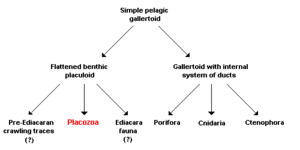Placozoans facts for kids
Quick facts for kids Placozoans |
|
|---|---|
 |
|
| Trichoplax adhaerens | |
| Scientific classification | |
| Type species | |
| Trichoplax adhaerens |
|
| Families | |
|
Trichoplacidae |
The Placozoa are a group of very simple animals. They are a type of invertebrate, which means they don't have a backbone. In fact, they are the simplest animals known!
There is only one official species in the Placozoa group, called Trichoplax adhaerens. However, scientists think there might be other similar species that look almost the same.
These tiny creatures were first found in 1883. They don't have a common name, but their scientific name, "Placozoa," means "flat animals."
Contents
What are Placozoa?
Trichoplax is a very small, flat animal, usually less than a millimeter (about the size of a pinhead). It doesn't have a fixed shape, much like an Amoeba. But its top surface is always flat.
Its body has two main layers of cells. The outer cells have tiny hairs called flagella. These flagella help the animal slowly glide along the bottom of the ocean. Inside, there's a loose network of cells and a liquid-filled space.
How Placozoa Eat and Reproduce
Trichoplax eats by absorbing tiny food particles, mostly microbes, from its underside. It basically digests its food outside its body!
These animals usually make copies of themselves without a partner. They can do this by simply dividing into two, or by budding off a small piece that grows into a new animal. They can also reproduce sexually, but this is less common.
Even though Trichoplax has a small amount of genetic material compared to other animals, many of its genes are similar to those found in more complex animals.
Discovering More About Placozoa
For a long time, scientists thought the Trichoplax they were studying were just young forms of other animals. But in the 1960s and 1970s, researchers realized these were actually adult animals. This discovery led to more interest in studying them, not just in labs, but also in their natural ocean homes.
Images for kids
See also
 In Spanish: Placozoa para niños
In Spanish: Placozoa para niños



